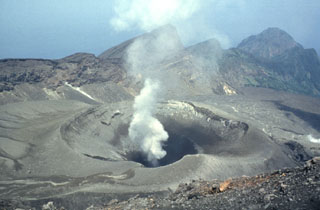Report on Suwanosejima (Japan) — 29 January-4 February 2025
Smithsonian Institution / US Geological Survey
Weekly Volcanic Activity Report, 29 January-4 February 2025
Managing Editor: Sally Sennert.
Please cite this report as:
Global Volcanism Program, 2025. Report on Suwanosejima (Japan) (Sennert, S, ed.). Weekly Volcanic Activity Report, 29 January-4 February 2025. Smithsonian Institution and US Geological Survey.
Suwanosejima
Japan
29.638°N, 129.714°E; summit elev. 796 m
All times are local (unless otherwise noted)
The Japan Meteorological Agency (JMA) reported that eruptive activity at Suwanosejima's Ontake Crater continued during 27 January-3 February. Incandescence was observed nightly in webcam images. An explosion was recorded at 0456 on 29 January though emission characteristics were unknown. Explosions at 0737 and 1740 on 2 February generated ash plumes that rose 400 m above the crater rim and drifted SE and 1 km above the crater rim and drifted S, respectively. Large blocks were ejected 400 m from the crater. Tremor accompanied the eruption events. The Alert Level remained at 2 (the second level on a five-level scale) and the public was warned to stay at least 1.5 km away from the crater.
Geological Summary. The 8-km-long island of Suwanosejima in the northern Ryukyu Islands consists of an andesitic stratovolcano with two active summit craters. The summit is truncated by a large breached crater extending to the sea on the E flank that was formed by edifice collapse. One of Japan's most frequently active volcanoes, it was in a state of intermittent Strombolian activity from Otake, the NE summit crater, between 1949 and 1996, after which periods of inactivity lengthened. The largest recorded eruption took place in 1813-14, when thick scoria deposits covered residential areas, and the SW crater produced two lava flows that reached the western coast. At the end of the eruption the summit of Otake collapsed, forming a large debris avalanche and creating an open collapse scarp extending to the eastern coast. The island remained uninhabited for about 70 years after the 1813-1814 eruption. Lava flows reached the eastern coast of the island in 1884. Only about 50 people live on the island.

